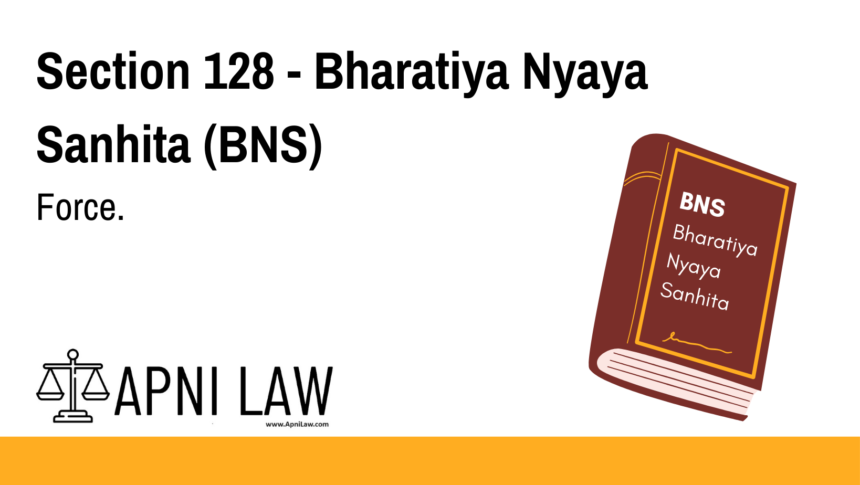Code: Section 128 BNS
A person is said to use force to another if he causes motion, change of motion, or
cessation of motion to that other, or if he causes to any substance such motion, or change of
motion, or cessation of motion as brings that substance into contact with any part of that
other’s body, or with anything which that other is wearing or carrying, or with anything so
situated that such contact affects that other’s sense of feeling:
Provided that the person causing the motion, or change of motion, or cessation of
motion, causes that motion, change of motion, or cessation of motion in one of the following
three ways, namely:––
(a) by his own bodily power;
(b) by disposing any substance in such a manner that the motion or change or
cessation of motion takes place without any further act on his part, or on the part of
any other person;
(c) by inducing any animal to move, to change its motion, or to cease to move.
Explanation of Section 128 BNS
Section 128 of the Bharatiya Nyaya Sanhita (BNS), 2023, defines the concept of force in criminal law. It lays down three specific ways in which force can be applied to another person. This section plays a crucial role in legal cases involving physical contact, assault, and other offenses where force is an element.
Key Provisions:
- Definition of Force:
- Force includes motion, change of motion, or cessation of motion caused by one person on another.
- It also includes actions that bring an object into contact with another person, directly or indirectly.
- Three Ways Force Can Be Used:
- Bodily Power: The direct use of physical strength to cause motion. Example: Pushing someone.
- By Disposing of a Substance: Placing an object in a manner that causes motion without further action. Example: Setting a trap that makes a rock fall on someone.
- By Inducing an Animal: Using an animal to apply force. Example: Provoking a dog to attack someone.
Illustrations
Example 1: Pushing Someone
If A pushes B, causing B to fall, A has used force under Section 128 BNS by bodily power.
Example 2: Throwing a Stone
If X throws a stone at Y, and it hits Y, this qualifies as force because X caused the stone’s motion to bring it into contact with Y.
Example 3: Releasing a Bull
If P releases a bull into a marketplace, knowing that it will charge at people, P is using force through an animal.
Common Questions and Answers on Section 128 BNS
1. What is considered “force” under Section 128 BNS?
Force includes any motion, change of motion, or cessation of motion caused to another person, either directly or indirectly.
2. Is accidental contact considered force under this section?
No. For an act to be considered force, it must be intentional or knowingly caused by a person.
3. Can indirect actions be considered the use of force?
Yes. If a person sets up an event that causes force (such as throwing a ball that hits someone), it falls under Section 128 BNS.
4. How does Section 128 BNS relate to assault?
Force is often an element of assault under Section 129 BNS (Read Section 129 BNS).
5. Can using animals to attack someone be considered force?
Yes. If someone incites an animal to move aggressively towards another person, it is categorized as force.
Conclusion
Section 128 of the Bharatiya Nyaya Sanhita defines force comprehensively, covering direct physical actions, indirect actions through objects, and the use of animals. Understanding this section is crucial for legal cases involving assault, bodily harm, and criminal force.
For more legal insights, visit ApniLaw today! 🚀








